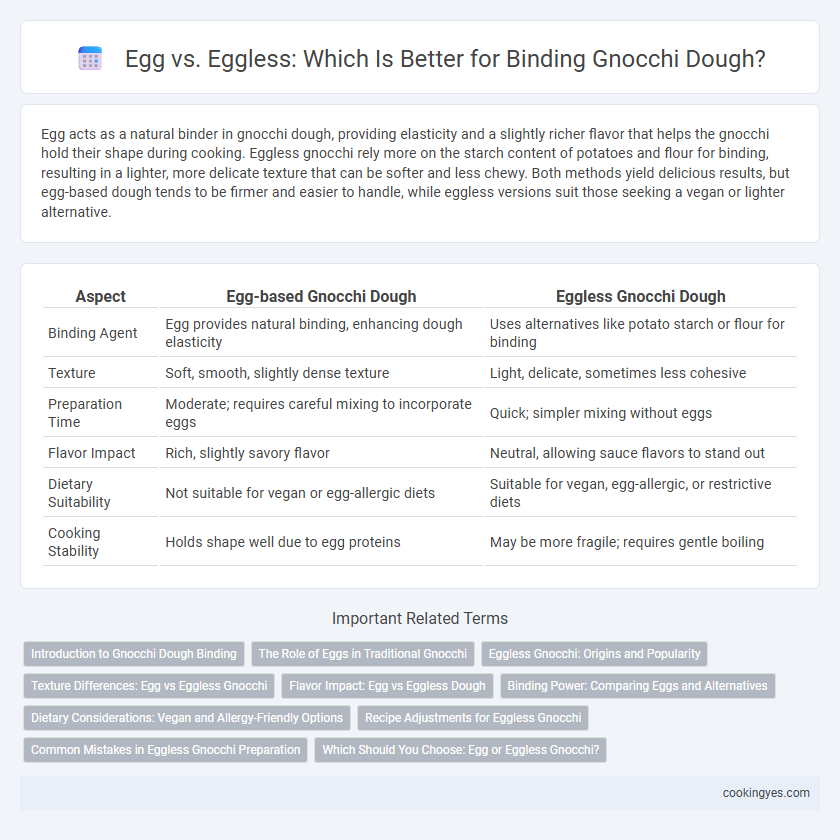Egg acts as a natural binder in gnocchi dough, providing elasticity and a slightly richer flavor that helps the gnocchi hold their shape during cooking. Eggless gnocchi rely more on the starch content of potatoes and flour for binding, resulting in a lighter, more delicate texture that can be softer and less chewy. Both methods yield delicious results, but egg-based dough tends to be firmer and easier to handle, while eggless versions suit those seeking a vegan or lighter alternative.
Table of Comparison
| Aspect | Egg-based Gnocchi Dough | Eggless Gnocchi Dough |
|---|---|---|
| Binding Agent | Egg provides natural binding, enhancing dough elasticity | Uses alternatives like potato starch or flour for binding |
| Texture | Soft, smooth, slightly dense texture | Light, delicate, sometimes less cohesive |
| Preparation Time | Moderate; requires careful mixing to incorporate eggs | Quick; simpler mixing without eggs |
| Flavor Impact | Rich, slightly savory flavor | Neutral, allowing sauce flavors to stand out |
| Dietary Suitability | Not suitable for vegan or egg-allergic diets | Suitable for vegan, egg-allergic, or restrictive diets |
| Cooking Stability | Holds shape well due to egg proteins | May be more fragile; requires gentle boiling |
Introduction to Gnocchi Dough Binding
Gnocchi dough binding relies on the balance of starch, moisture, and binding agents to achieve the perfect texture. Eggs provide natural proteins that strengthen the dough and improve elasticity, resulting in a tender yet firm gnocchi. Eggless recipes often depend on the starch content of potatoes and flour to bind the dough, creating a lighter, more delicate texture ideal for those seeking vegan or allergy-friendly alternatives.
The Role of Eggs in Traditional Gnocchi
Eggs in traditional gnocchi serve as a crucial binding agent, providing structure and elasticity to the dough, which helps prevent the gnocchi from falling apart during cooking. The protein in eggs coagulates upon heating, contributing to a firmer, more cohesive texture that can support delicate shapes made from potato and flour. Eggless gnocchi rely solely on the starch from potatoes and flour for binding, often resulting in softer, more tender gnocchi that may require gentler handling to maintain their form.
Eggless Gnocchi: Origins and Popularity
Eggless gnocchi, rooted in traditional Italian regions like Campania and Basilicata, emphasizes potato and flour as primary binders, reflecting a rustic, dairy-free heritage. This variation gained popularity due to its softer texture and suitability for vegetarian and allergy-sensitive diets, enhancing its global appeal. The absence of egg results in a lighter, more delicate dough that absorbs sauces differently, preserving the authentic taste of regional Italian cuisine.
Texture Differences: Egg vs Eggless Gnocchi
Egg gnocchi dough yields a firmer and silkier texture due to the protein structure eggs provide, resulting in dumplings that hold their shape well during cooking. Eggless gnocchi tend to be softer and more delicate, often requiring careful handling to prevent them from becoming too mushy or falling apart. The absence of eggs increases reliance on potato and flour ratios to achieve the desired elasticity and bite.
Flavor Impact: Egg vs Eggless Dough
Egg-based gnocchi dough offers a richer, silkier texture and adds a subtle savory depth that enhances overall flavor complexity. Eggless gnocchi tends to highlight the natural taste of potatoes more distinctly, providing a lighter, cleaner palate ideal for delicate sauces. Choosing egg or eggless dough directly influences the dish's mouthfeel and the flavor profile, making it crucial to match dough type with desired culinary outcomes.
Binding Power: Comparing Eggs and Alternatives
Eggs provide strong binding power in gnocchi dough due to their protein content, which helps hold ingredients together and improves dough elasticity. Eggless alternatives like potato starch, cornstarch, or tapioca flour also offer effective binding by absorbing moisture and creating a gel-like consistency, though they may result in a slightly denser texture. Choosing between eggs and eggless options depends on dietary preferences and desired texture, with eggs generally yielding softer gnocchi and starches providing firmer, more cohesive dough.
Dietary Considerations: Vegan and Allergy-Friendly Options
Gnocchi dough can be prepared with or without eggs to accommodate dietary needs, making eggless gnocchi an ideal choice for vegan and allergy-friendly diets. Using alternative binders such as potato starch or tapioca flour ensures a soft texture while avoiding egg allergens. This approach caters to individuals with egg allergies and those seeking plant-based options without compromising traditional gnocchi quality.
Recipe Adjustments for Eggless Gnocchi
Eggless gnocchi dough requires increased moisture and binding through ingredients like ricotta cheese, mashed potatoes, or a small amount of flour to maintain the delicate texture. Adjusting the dough's hydration by adding a few tablespoons of warm water or plant-based milk ensures pliability without compromising softness. Careful handling and minimal kneading help prevent toughness often caused by the absence of egg as a binding agent.
Common Mistakes in Eggless Gnocchi Preparation
Eggless gnocchi dough often suffers from insufficient binding, leading to a crumbly texture that fails to hold shape during cooking. Common mistakes include using too much flour to compensate for the missing egg, which results in dense, heavy gnocchi rather than soft, pillowy bites. Properly cooking and cooling potatoes before mixing and incorporating a minimal amount of water can improve dough elasticity and prevent disintegration in eggless recipes.
Which Should You Choose: Egg or Eggless Gnocchi?
Egg gnocchi dough provides a richer texture and enhanced binding due to the protein content in eggs, which helps the dough hold together better during cooking. Eggless gnocchi, often made with just potatoes and flour, suits vegan diets and produces a lighter, more delicate dumpling texture but may require careful handling to prevent falling apart. Choosing between egg and eggless gnocchi depends on dietary preferences and desired texture, with egg adding structure and richness while eggless options offer softness and suitability for allergy-conscious eaters.
Egg vs eggless for gnocchi dough binding Infographic

 cookingyes.com
cookingyes.com